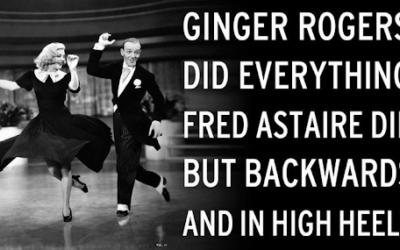When I was early in my career, I sought leadership positions because I felt compelled to achieve my higher purpose through my career. I set out on a personal development plan for leadership believing it would make me a better, and more impactful person. But I soon became very disappointed with what passed for leadership development in the companies I worked for.
My first leadership development training felt like a colossal waste of time. We all got our MBTI scores and then sat in a room gazing at our navels for a day. It was fun (I still have the pen they gave me), but I didn’t understand at the time why we were doing it. Fast forward a few decades and I get it. Here are the missing pieces that I didn’t understand at the time:
- Leadership is not about doing many things (in the weeds)
- Leadership is about making sure important things get done (from the bushes and treetops)
- Leaders need to motivate and inspire people to get those things done that we can’t do ourselves
- Sometimes we need to hop down into the weeds and whack alongside the troops, while maintaining the vision and perspective we gain at higher altitudes
- Leaders need to understand people, including themselves, well enough to motivate and inspire others to get the right things done – MBTI and other emotional intelligence tools can help with that
Seems pretty straightforward, now, of course, but at the time, this insight would have really helped me make better use of my leadership development opportunities and create a personal development plan for leadership that might have saved me a lot of stress and confusion.
But frankly, back then I’m not sure I would have believed that leadership was more about leading than doing. I had to learn some hard lessons before I came to those beliefs. So in the hope that my learning can benefit you, here’s what I wished I’d known, and believed way back then.
Perspective is everything: You can’t lead from the weeds
When you move into management and leadership one of the hardest lessons to learn is that you now have two jobs you need to juggle. In addition to the job of doing the day-to-day work, you have a second job you must do in parallel, which is getting up above the day-to-day work and looking for trends, patterns and strategies to improve how to achieve outcomes and impact, which is not the same as all the activity in the work itself.
I like the analogy of doing the work “in the weeds” versus taking perspective on the work “from the treetops.” This follows a navigation analogy. To get somewhere you have to do the work, you have to travel by foot or vehicle (in the weeds), following a direction and plan you set before you set out for your destination. This travel plan is set from the treetops, focused on your destination and the obstacles and enablers you’re likely to find along the way.
Unfortunately we have not yet invented GPS for leadership, so the work of leading is more like the old days where you’d head out in a direction, encounter reality in the form of washed out roads, downed trees in your path and myriad other problems you didn’t anticipate in the planning phase. The solution is often to find the nearest tree and scale it. From the top of the tree you can see the path ahead with more clarity, adjust the travel plan, climb back down the tree and continue on your way, making adjustments as you go.
Here’s the thing, in leadership, you have to scale up into the treetops to check the path ahead (and behind) much more frequently than most of us actually do. Like, daily. If you don’t get out of the weeds on a very frequent basis, you lose sight quickly of those trends and patterns you’re trying to change and use to achieve your results. By contrast, when you do get out of the weeds, the perspective you gain helps you set new priorities more easily and can reduce your stress with these revised priorities.
Photo by Zac Durant
We can become our best selves through our work by developing our interpersonal communications skills
I’ve always thought that making a positive difference in the world through my work was a necessary part of becoming my best self. There is research on adult development that demonstrates that our maturity as humans, no matter our age until we die, includes an expansion of what we care about beyond ourselves, to include others; not just our families but our communities and our world.
Not surprisingly, this progression towards greater levels of caring and maturity parallel the skills necessary for organizational leaders to excel and achieve positive, sustainable results for their businesses. So in short, yes, becoming a good leader can mature you into a better version of yourself, and vice versa.
I know many people, clients and acquaintances both, who want to be good leaders and want to be good people, but find themselves frustrated by the realities of having to work with other people. Because, let’s face it, we human beings are frustrating! We don’t think or act the same, are unpredictable, are often poor communicators and have bad days at the most inconvenient times. And it is exactly the kinds of skills that leaders develop to work with these unavoidable human dynamics that help us achieve great things. This is why leadership is not for the faint of heart and any personal development plan for leadership has to include becoming better at working with people.
But how?
There are many answers to this question, but I find the single most important skill area to help us work productively with others in ways that mature us is to become an excellent interpersonal communicator. Most of us underestimate what it takes to communicate effectively, but when we look at communication as a system within us, through which we put our ideas into the world and receive feedback about them that helps us refine what we put into the world, we have a lot of power to become good at it.
And the better we become at communicating interpersonally the better our organizational communication becomes.
It just takes discipline to pay attention to what works and what doesn’t, adjusting and learning along the way. Not a quick win, but an important one that teaches you a lot about yourself, other people and the world.
Personal Development Plan for Leadership: Two keys to leading as your best self
So these two skill-building areas for leadership are useful personally, but how can we use them to become effective in leading our organizations? Much of my career as a coach has been in search of the tools to achieve organizational success by becoming better people. There is a ton of information out there on being a good human and a good leader, but a lot of it describes people who’ve already accomplished it without giving much actionable insight into how they got there.
But there is one, highly actionable, instrument that I use for telling us what makes an effective leader, and it even gives us a way to measure ourselves to see where we’re being our best self in ways that leads to better results, and where we’re not. Here is one of my favorite findings from this tool, the Leadership Circle Profile, which are the two leadership skills most highly correlated with leadership effectiveness:
- The ability to be “Purposeful & Visionary” measures the extent to which you clearly communicate and model commitment to personal purpose and vision. (91% correlated with effective leadership)
- The ability to foster “Team Play,” which measures your ability to generate high-performance teamwork among team members who report to you, across the organization, and within teams in which you participate. (89% correlated with effective leadership)
There are, in fact, a total of eighteen abilities like the ones above, that characterize strong leaders, but these two rise above the rest for their ability to bring out the best in us. It’s my experience, actually, that in conjunction, strong abilities in these two areas tend to pull up our strengths in the other sixteen areas as well.
Why is that and how can we get more of it?
The answer is both simpler and more complex than you might expect. It turns out that everything flows when a leader has a strong sense of purpose, both personally and for the work activities they are leading. Plenty of research demonstrates that leaders who are driven by a strong sense of purpose do achieve better results. I believe this is because a positive vision of the future you feel compelled to create helps you filter and sort through the lists of tasks, proposals, opportunities to use resources etc. and make aligned choices about how best to use the time and energy you have, both yours and your group’s, to achieve that outcome. Without a purpose driving your decisions, everything can feel either optional or become vulnerable to the leader’s personal biases.
This is why I feel so strongly that everyone serious about their career and leadership advancement should invest in developing a personal brand strategy grounded in a personal purpose which lights them up and guides them every step of the way.
So what should you do?
When I think back on my early leadership experiences, and the less-than-helpful leadership development activities I engaged in, I would have liked a personal development plan for leadership that taught me that if I did these things, I would achieve more impact and become a better person:
- Take the time and energy to get in touch with your personal purpose and build your personal brand around it – checking back in with it often (at least once a quarter)
- Spend a little time each morning in the treetops, refocusing on the vision, before jumping into the weeds
- Spend a little time before leaving for the day jumping back into the treetops to set the next day’s priorities
- Spending my own time and energy fostering that trust and safety with the people I work with, and seeing that as part of my job, believing that when trust and safety in collaboration is present, work results improve
This kind of personal development plan for leadership would probably have gotten me farther, faster and helped me feel more grounded and less stressed along the way. Hopefully it will do that for you, now!
Worklife Reset for an Energized, Authentic Personal Brand
Workbook & Toolkit







